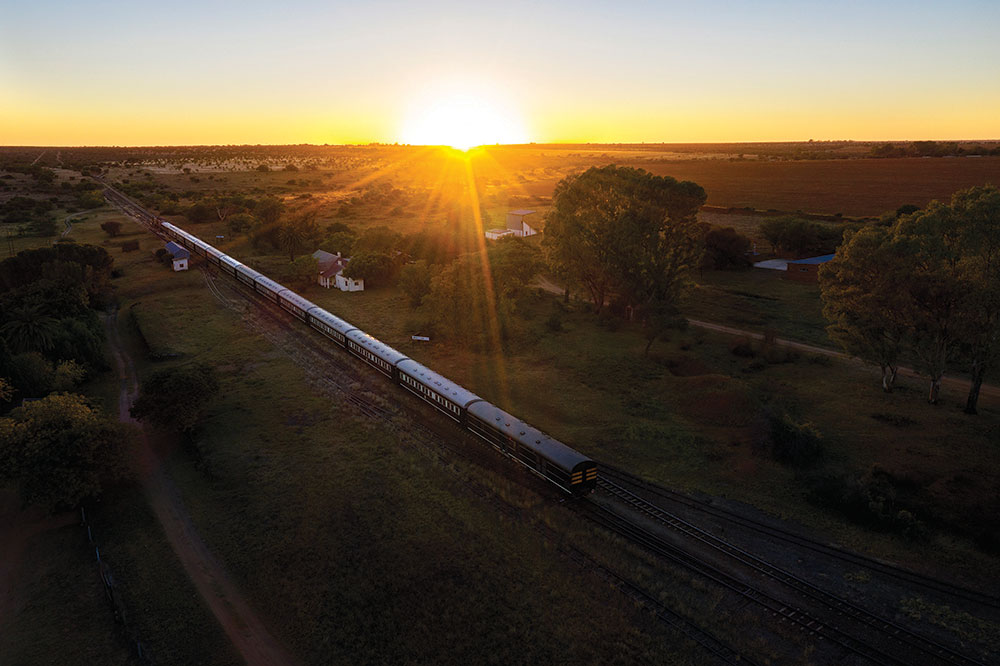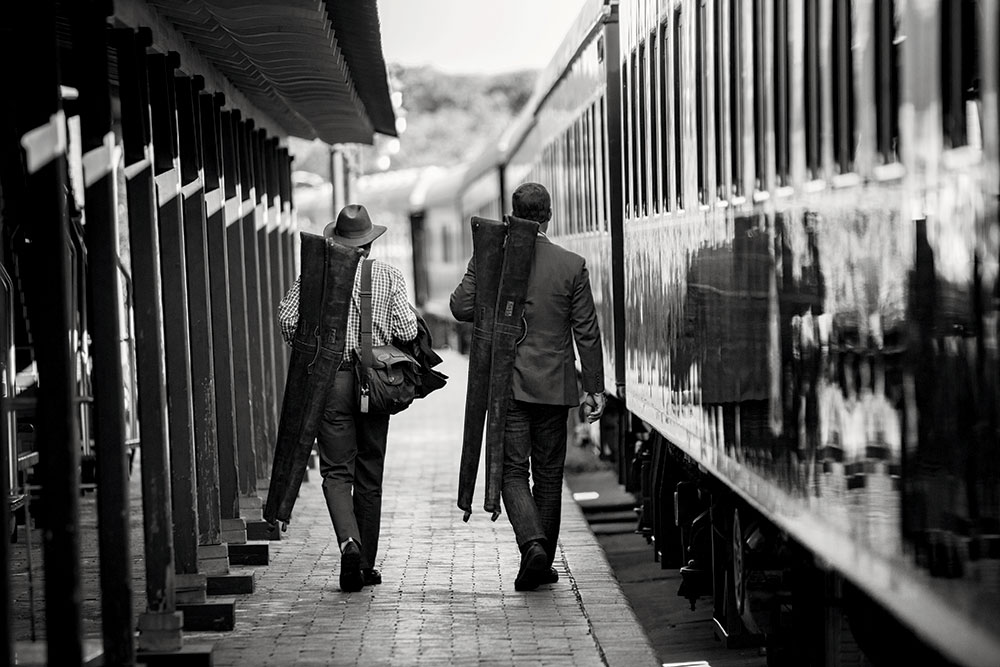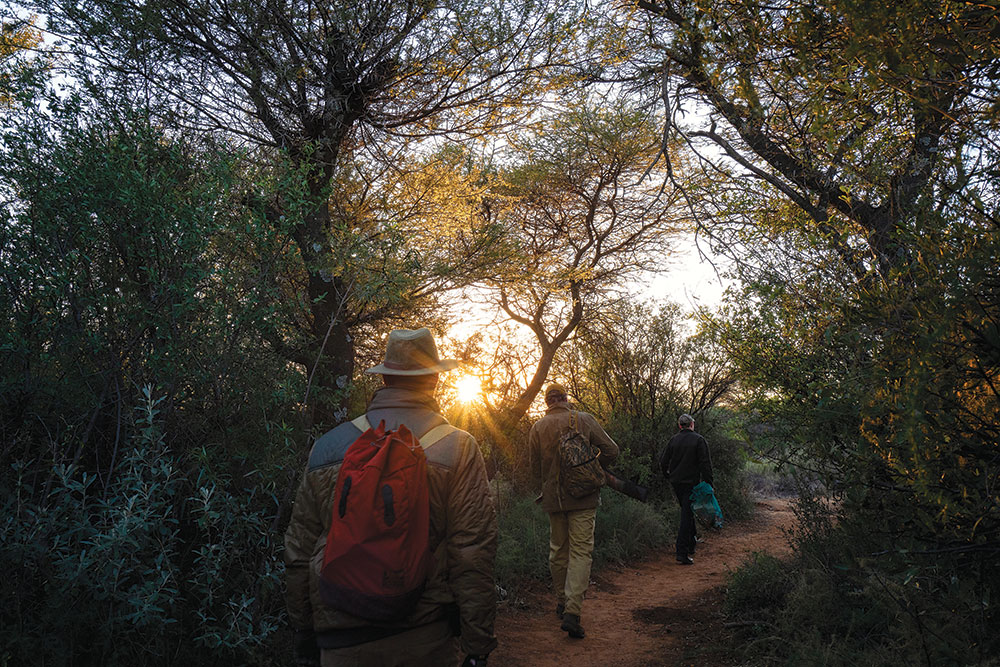Roaming Rails

People feel an affection for trains, which is a link to their past, perhaps. “Link” is a good word. Train cars link to each other, in turn connecting people together from car to car. Today, more than ever, we all seem hungry for a sense of connection.
The South African sun beat down upon our shoulders as we stepped foot onto the unknown ground before us. For many years, my close friends, Gil Morgan and Terry Allen, and I had imagined what our time aboard the Rovos Rail would be like. But, what we encountered far exceeded our expectations.
As we transitioned from the hustle and bustle of the streets of Pretoria, South Africa, to what appeared to be an antiquated train station with touches of a modern hand, we were immediately swept back in time. At the refurbished station—first built in the 1920s—a three-piece music ensemble greeted us. Soft sounds of the Golden Age filled the air as the trio played, and when the songs ended, voices in familiar accents hit my ears. I overheard one couple discussing their travel from Las Vegas and another from the mountains of Montana. I noticed a Texas twang from a few others and realized this group was headed on the same journey as us. We were all boarding Rovos Rail’s “Pride of Africa” locomotive for an eight-day hunting safari through the country’s diverse landscapes.
As I began conversing with the other travelers, the conversation quickly shifted to upland hunting. It was then that I realized it wasn’t our American origins that connected us, but our love of wingshooting brought us all there together.
Almost on cue, all passengers gathered to witness the ar-rival of the olive-green locomotive with the Bushveld as its backdrop. The train halted, and a fleet of bellmen emerged with trays of fine spirits and wine. Before boarding, a red carpet was placed at our feet, as if we were guests entering a West Egg soirée. To me, this was all new and unfamiliar treatment and felt like something from a bygone era. For Rovos Rail, this type of service is tradition, a practice that is completely standard for all of their trips. They spare no expense to ensure safe and memorable travels aboard their grand locomotives.
Rovos Rail, a private, luxury railway company, was started in 1989 by Rohan Vos, a lover of trains and all things mechanical. Greatly influenced by his friend, Rohan attended an auction in 1985 with the intention of buying and restoring a coach or two. He left the auction having purchased several more than intended, and the rest was history. When it was all said and done, his finished train consisted of a locomotive and seven carriages, and he launched the train on April 29, 1989 with four paying passengers.
More than 30 years later, the family-owned company currently operates out of Capital Park Station in Pretoria and offers a range of journeys on various routes from Cape Town, South Africa, to Tanzania and Namibia. Rovos Rail has understandably earned an international reputation for uniquely curated adventures of all types, with some specifically planned for sportsmen and sportswomen.

My fascination with trains began as a young boy. Where I grew up in Alabama, we had a train line that ran through the middle of my hometown. I have memories of waving at the men operating the train as it passed, then excitedly collecting my flattened pennies from the tracks. One day, a dream came true when my best friend and I were allowed to ride the local train through town. We both took turns blowing the horn as we charged down the tracks at every crossing. This experience from my youth heightened my curiosity for the world of trains and how they worked.
As my interest in trains grew over time, so did my need for finding new parts to complete my own set. Each year at Christmas, I would ask for more tracks and more cars. My set had switch tracks, bridges, and every train car one could imagine. The locomotive even smelled like smoke that comes from the steam engines as they roam the rails. I placed the tracks around every corner and through every doorway of my house, to the certain dismay of my parents and siblings.
So about five years ago, my deep-seated affinity for trains was again sparked when friends started talking about a trip aboard the Rovos Rail. After hearing glowing remarks from travelers on the Pride of Africa, I tucked away my yearning for the trip as a possible, but maybe not likely, bucket-list item for the future. Each year, Rovos Rail continued to come up in our conversations, and my interest grew and finally spilled over. Africa, bird hunting, and trains: How could one go wrong on a trip like that? There was no more waiting. It was time to hop on those rails in Pretoria, South Africa.

Aboard the train, with our bags and guns in tow, we followed suit and headed to our room assignments. Once settled in, we all congregated to the lounge car for afternoon cocktails that were followed by dinner. Colors of red, green, and gold surrounded us and echoed Art Deco lines and accents from the 1920s. After an extensive exploration of our accommodations for the next eight days, we settled at the caboose in the magnificent open-air observation car. I knew that many nights would be spent there recounting the day’s events while sipping a libation, enjoying a cigar, and watching the South African landscape pass by.
The following days were filled with rich culture, exquisite hospitality, and superlative bird hunting. From dinner service and themed nights in the dining car to turn-down and laundry service, every want and need was anticipated by the Rovos staff. Most meals were served aboard the train on tables adorned with white linens. Every morning, we were greeted with hot coffee and tea along with an assortment of fresh fruits and pastries. We could also choose from any made-to-order breakfast prepared fresh by the chef in the galley. Dinners aboard the train were always an extravagant event. Jackets and party dresses, as well as top hats and even feather boas, made their debut under starry skies. Evening meals were always followed by a wonderful dessert and an after-dinner drink.
On a few occasions, incredible meals were served outside in the open African air. After a long day’s hunt, it was refreshing to sit outside in the middle of the bush surrounded by bomas, or community enclosures. On several days in the field, we were served a lunch box that was fit for a king, complete with an assortment of meats, cheeses, and a bottle of wine to wash it all down. At the conclusion of every afternoon hunt, we were greeted by a warm fire and a complete bar in the field. It was there where conversations unfolded about the day’s hits and misses. After the camaraderie concluded, we would head back to the train where the staff would be at attention with warm towels and our favorite cocktail.
Each morning was met with a new wingshooting challenge, ranging from guinea fowl and partridge to rock pigeon and spur-winged geese. On the fifth day, we were set to hunt a variety of ducks downstream from the Vaalharts Valley near Warrenton. Locals and their families met us to help with the guns, shells, and retrieving. These wild ducks—shelducks, white-faced whistling ducks, yellow-billed ducks, and red-billed teal—were large and came in like pigeons as we stood in our makeshift blinds. It did not take long for the competition to ensue between the groups of shooters. The enthusiastic chanting and chatter by the locals made this day of wingshooting one to remember.
I was most excited about hunting guinea fowl. The group met the host along with a group of young men and women that would be our hunt partners for the day. We then drew numbers to identify the stand position where we would start the hunt. As we were dropped off at our stations, we heard loud noises in the distance by what seemed to be an entire tribe of people marching our way. It was a South African version of an English driven shoot, where chants were used instead of flags. It did not take long before loud chirping from the birds made their way toward the line of hunters. And then to my surprise, a warthog came running by my stand, and I thought to myself, I am definitely not in Alabama anymore.

There was a full itinerary for non-hunters as well. Some of the spouses took to the field with their partners, and others took day trips that involved riding airplanes, viewing wild animals, and visiting private clubs. On day four, the entire group took a trip to Kimberly for a tour of the city, the Diamond Mine Museum, and the extraordinary Big Hole, which is potentially the deepest open mine excavated for diamonds by hand and can be seen from space. After our mine excursion, we enjoyed a visit and a wonderful lunch at the famous Kimberley Club that was founded in 1881. Other day trips involved safaris to local game preserves, visiting of local museums, and more.
On the last day of hunting, our group finished with a fantastic day of guinea fowl shooting. We gathered for a break around a table full of small bites along with wine and beer. As we talked about the week of shooting, our host said that our entire team of local helpers had prepared some songs that they wanted to sing for the group. Men and women, both young and old, stood in three rows and began to chant, sing, and dance. They had been practicing these songs for weeks. They started with one song, which became two and then three. The more they sang, the more we were moved. We had traveled many miles to board a train and enjoy some wingshooting in the plains of South Africa, and there we stood in humble awe of the gratitude and joy shown to us by these people.
As our train slowly traversed down the tracks back to Pretoria, we sat as a group in the observation car—some talking, some not. Mostly, we were looking out the windows at the landscape as our train snaked back towards our starting point. I could not help but think back to the beginning when we first pulled into that old train station, seeing lots of unfamiliar faces from all walks of life. Eight days later, I looked around at a group of new friends that had just spent a first-class week together on a train with one common thread: wingshooting.
No matter what part of the world we came from, what our occupations may be, or even how we all ended up aboard that train, nothing really made much difference. The trip tied us together forever. Our friendships were woven into a greater community, one that transcends country lines. I have said it before, and I will probably say it again: The hunt is more than just the pursuit. It gives us the chance to connect to others, which is the most important part. And aboard the Rovos Rail, that connection between trains and tracks and hunters and friends is all but guaranteed.
Originally published in Volume 8, Number 5 (August-September 2022) of Covey Rise.
























